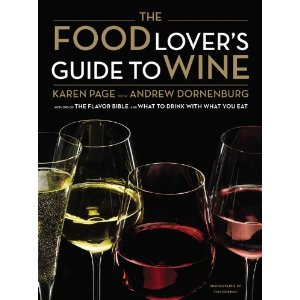 According to USA Today last week, the purchase of wine has gone up 14% this year and, for the first time, people are buying more wine than wine glasses! Good news: Smart public and better wine glasses. Another sociological shift is that people are buying more "experiences" (self-care, self-improvement) and products with more "prestige." That's a perfect fit for wine, and good news for Carol Berman, who runs Class in a Glass wine-tasting programs all over the country. It's also good news for the authors of the Food Lover's Guide to Wine (Little, Brown and Company), written by Karen Page and Andrew Dornenburg. Just named one of the five best wine books of the year by the Wall Street Journal, the book addresses a curious public's need-to-know as they experience and buy more prestige wines.
Their mission? To encourage more Americans to switch from their typical beverage of choice (i.e. a soft drink, like Coke or Pepsi, which is what a majority of Americans enjoy with their evening meal) to a glass of wine with dinner -- so one of the most important features of the book is a list of 150+ wines under $15. For just a dollar or two more per serving, everyone can enjoy something healthful and delicious that will make their dinner taste much better.
According to USA Today last week, the purchase of wine has gone up 14% this year and, for the first time, people are buying more wine than wine glasses! Good news: Smart public and better wine glasses. Another sociological shift is that people are buying more "experiences" (self-care, self-improvement) and products with more "prestige." That's a perfect fit for wine, and good news for Carol Berman, who runs Class in a Glass wine-tasting programs all over the country. It's also good news for the authors of the Food Lover's Guide to Wine (Little, Brown and Company), written by Karen Page and Andrew Dornenburg. Just named one of the five best wine books of the year by the Wall Street Journal, the book addresses a curious public's need-to-know as they experience and buy more prestige wines.
Their mission? To encourage more Americans to switch from their typical beverage of choice (i.e. a soft drink, like Coke or Pepsi, which is what a majority of Americans enjoy with their evening meal) to a glass of wine with dinner -- so one of the most important features of the book is a list of 150+ wines under $15. For just a dollar or two more per serving, everyone can enjoy something healthful and delicious that will make their dinner taste much better.
One of the book's special features is an A-to-Z reference of more than 250 different wines and their flavor profiles. You can see, at a glance, how to pronounce the name of a wine (a stumbling block for many novices), can anticipate what the wine is likely to taste like (who knew that an Austrian riesling might have a hint of kaffir lime), learn how to serve it, discover the wine's most notable producers, and, most importantly, learn what foods to enjoy with it. Perhaps this is the team's greatest wish for you in, what may be, their best book yet.
The book begins with a brief history of wine in America, which parallels the history of the United States itself. Few know that the settlers at Jamestown in the early 1600's were commanded by the King to grow grapevines, in the hope of developing a wine industry that would give England a cheaper source of wine than France or Spain. And few know that we are drinking the passion of our forefathers -- from George Washington to Thomas Jefferson -- in a shared love of wine and wine-making.
In a frenzied and scholarly approach to this vast subject, the four-legged team scoured the country for the best sommeliers from coast to coast -- representing restaurants such as Blue Hill, CityZen, Daniel, The French Laundry, The Inn at Little Washington, Manresa, No.9 Park and Spago -- where they gleaned insights and secrets from dozens of cellar zealots who cumulatively represent decades of training and on-the-job experience. Like scientists in a sexy lab, they distilled all the knowledge into a chart of essential knowledge -- that would generally take a lifetime to learn. I loved the "insider info" and relished some unexpected food and wine-pairing notions: Cashew chicken with Chinon (an idea from Virginia Philip at The Breakers), or an almond-thickened tomato gazpacho with a sparkly Cremant d'Alsace from Agape (a match made by Belinda Change at The Modern).
Their top ten secrets about how to get more pleasure from wine include attributes that sound like "mindfulness" to me, including perceiving a wine's character, using your judgment, and sharing the experience. And as someone who has composed menus, instead of music, during my 35-year career for legendary restaurants such as the Rainbow Room, Windows on the World, and the Hudson River Club, I particularly loved the kindred sentiment from Richard Olney in The French Menu Cookbook (1970). "Wine's principal role is to give pleasure, and that role is best played at the table in the context of a menu; when the two are carefully chosen, the wine and the food enhance each other, each subtly altering the other."
Page and Dornenburg, who have also written The Flavor Bible and What to Drink with What You Eat, humbly admit, however, that you can never know it all and feel excited to learn something new about wine every day. Why not crack open a bottle and take a peek into their book on YouTube? Imagine what George Washington would have to say about that.